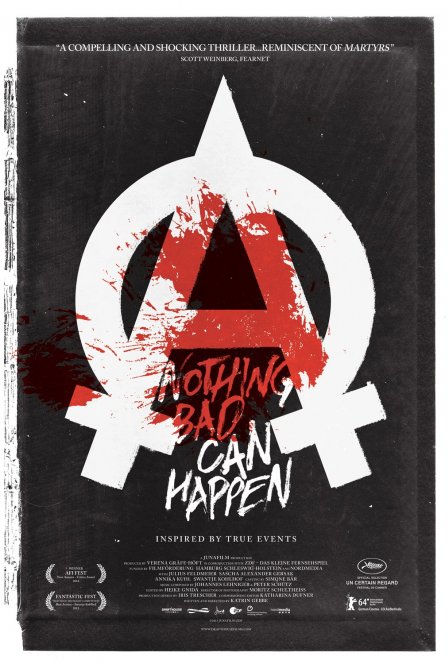The greatest shock of director Katrin Gebbe’s ironically titled Nothing Bad Can Happen isn’t the violence and increasingly horrible scenarios endured by the film’s protagonist, Tore (Julius Feldmeier) — a hardcore, self-described Jesus freak — but rather the confidence this young director has behind the camera in her first feature. Serving as both writer and director, Gebbe weaves a pitch-black tale (supposedly based on true events) examining the extremes of society through a twisted game of wills. Tore is a true believer with an unshakable faith in Jesus, despite his grunge-rock appearance and nomadic lifestyle. He interprets his seizure-induced hallucinations as holy messages and upholds a strict moral code in order to save himself from the “evils” of the world. By chance, he meets Benno (Sascha Alexander Gersak), a man who embodies everything Tore is not. Lust, jealousy, and greed motivate Benno, along with a sadistic desire to see the helpless suffer. When Tore goes homeless, Benno brings him home in what first seems like an act of kindness. But as the film progresses through three distinct chapters — faith, love, and hope — Benno terrorizes Tore. What begins as verbal abuse escalates into physical, psychological, and finally sexual violence. Gebbe treats the film like an onion, slowly pulling back the layers, unraveling even more disturbing scenarios, especially when Tore befriends and attempts to help a young woman living with Benno (Sanny, played by Swantje Kohlhof).
Although it’s tempting to connect Nothing Bad Can Happen to the still-evolving Berlin School movement in German cinema, the film shares more with Austrian director Ulrich Seidl’s recent Paradise trilogy — Paradise: Love, Paradise: Faith, and Paradise: Hope. Like Ulrich’s trio of films, Nothing Bad Can Happen captures not only the darkness in our world born out of human nature, but also the corrupting influence of systems and structures (including religion) that we build and participate in. Tore’s complete devotion to his particular brand of religion renders him helpless, as demonstrated by one particularly powerful scene involving Benno drowning a cat. In the Benno vs. Tore struggle, we can plainly see the nature of violence as it plays out in the world everyday. The film ends as it begins, with a baptism of sorts, the final scenes taking place in the mud of a roadside creek. What starts as pure in this world is quickly sullied, a point Gebbe drives home with her use of natural lighting and a gritty aesthetic. The idiom “to hell and back” is often used to describe a situation in which we watch a character struggle but ultimately either come back to society or escape dire circumstances. Nothing Bad Can Happen is a ride to hell, but without a return ticket.
Nothing Bad Can Happen also serves as an interesting example of how film distribution has changed in the past few years. Officially listed as movie 21 of 29 in the Drafthouse Films lineup, the film continues the distributor’s trend of acquiring foreign titles that challenge audiences (see Borgman, Pieta, The Act of Killing, and R100). Although Drafthouse does occasionally acquire films that cater to the cult audience (Wake in Fright, Miami Connection), their distribution is primarily focused on new international cinema, the kind with few, if any, bankable stars. They rely on their own theaters, along with a number of independent theaters (often outside of the Landmark chain), to generate buzz around their films before releasing them direct to the public through their website (with the occasional title appearing on Netflix). The beauty of this system is that, when the films are finally released, Drafthouse has a built-in audience through its Drafthouse Alliance subscription service, sending each film directly to the house of the subscriber, along with posters and other bonuses throughout the year. In this way, Drafthouse appeals to the collector and the cinematically adventurous, their tight control on the method of distribution giving each film an aura of excitement and mystery. While not making their titles available on every streaming platform imaginable might limit the overall potential audience, ultimately the number of people actually watching a film like Nothing Bad Can Happen is going to be higher under this system. In a world of internet-fueled overabundance and choice, a curator’s hand is needed — this curator just happens to have the mailing address of cinephiles across the United States.
Another new distributor, A24 films, has also gained notoriety in the past few years, bringing titles like Denis Villeneuve’s Enemy, Harmony Korine’s Spring Breakers, and most recently, Steven Knight’s Locke to theaters. Like Drafthouse, their films are often edgy, sometimes pushing the boundaries of what audiences expect; unlike their Austin-based counterpart, they focus on films that clearly have a recognizable star. In this sense, A24 might seem like the MGM of old when compared to Drafthouse (“more stars than there are in heaven”), but both distributors are committed to finding quality cinema and getting it to smart audiences looking for more than just the usual box-office fluff. Not everyone can go the Shane Carruth route of self-distribution; having a company that understands and can actually reach an audience receptive to their film is appealing for filmmakers. While any moviegoer with a minimum knowledge of film knows what auteur theory is, perhaps we should be talking more about distributors as auteurs. Drafthouse and A24 have no set loyalties to directors, yet while browsing through their growing catalogs, it’s easy to spot aesthetic and thematic trends. Drafthouse in particular seems interested in exploring the nature of violence and capturing what happens in the dark, hidden corners of the globe, and Nothing Bad Can Happen is yet another excellent example.

